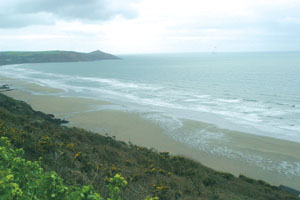is a huge bay located just a few miles to the west of
From
 |
Warning – parking can be found easily near all the marks in the form of beach car park laybys but roads to and from these areas are narrow and winding. During holiday season there will be increased traffic, the water will be full with bathers and big channel swells will attract surfers from all over the southwest! Fishing will be best if you stick to early mornings, evenings or overnight.
1 Queener Point
Once at
This mark is an all-species mark and will fish on both directions of tide, with the biggest tides being the best. Tactics include spinning and float fishing for mackerel and garfish, plugging for bass, and ragworm fished hard on the bottom, running-leger style will produce decent wrasse.
2 Main Beach
This long stretch of beach can be found just to the east of the
3 Fisherman’s
Just to the west and up the beach from the main beach you will find Fisherman’s. This is clear because of its rocky outcrops that spread from the cliffs and spill out onto the beach. Fisherman’s is a bass angler’s paradise. Fish evening flood tides and start by wading out and casting distance. As the tide pushes back, move with it until eventually, over the top of the tide, you will end up fishing on the rocks. Be careful not to get cut off though. Fish a single rod and a single bait of frozen or live sandeel, or multiple lugworm. Running legers or paternosters will work best; expect to see the fish sizes grow as the tide pushes up. The biggest fish always seem to fall just before the top of the tide and during the cover of darkness.
4 The Grotto
Back further west along the coast road you will find a small, gravelled car park located on a tight bend in the road. This car park is easily found because it has a huge yellow goalpost spanning the entrance.
The Grotto is the only real rock mark along this stretch of beach and provides some of the best action in the area. This mark is well known for producing some good double-figure bass. Funnily enough, a few of these have fallen in daylight to frozen sandeel while are bathers were in the water! The best times to fish the Grotto safely are early mornings and as the evening sets in. Plugging is possible and highly effective because a short cast will put you straight into deep water. Failing that, adopt the single hook, single bait tactic and sit it out for a decent fish.
5 Tregantle
Tregantle, yet again, is further west back along the coast road and is the first beach you will come to when approaching from
6 F Range
Just around the corner from Tregantle and a little bit further west down the beach you will find F Range. It’s easily found by walking along the water’s edge at low tide and looking back at the military firing ranges along the top of the cliffs. The last one to the west is F Range – fish right in front of here. Parking can be found in the same place as Tregantle and F Range is only a 20-minute walk from there.
F Range can be a funny spot, it’s generally shallower than the other beaches and will only fish during darkness and if the sky is overcast. The best bet is to leave this as your last option and fish one of the other beaches first. If that doesn’t work, make the trip to F Range, as it’s probably fishing well. This beach throws up small and big bass, so adapt your tactics to suit.
Tackle Shops
Devon Angling Centre, Unit 4-5, Orchard Meadow, Orchard Way, Chillington,
TSF Top Tip 1
Always carry a good selection of lures with you, just in case the bass and mackerel are willing to play ball!
TSF Top Tip 2
Make sure you’ve got some size 5/0 and 6/0 hooks with you, just in case the big bass are feeding.





